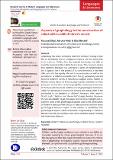| dc.contributor.author | Eliud Musotsi, Frida Miruka, Benard Okal | |
| dc.date.accessioned | 2022-01-23T10:36:09Z | |
| dc.date.available | 2022-01-23T10:36:09Z | |
| dc.date.issued | 2021 | |
| dc.identifier.uri | https://repository.maseno.ac.ke/handle/123456789/4573 | |
| dc.description.abstract | Graphology has today dominated children’s literature making it look
like an amorphous and an ambiguous creature with its relationship
to its audience. Children lack the required knowledge and skills to
associate meaning to the stylistic devices in use. This, however, means
that children’s literature has undergone a series of transformations
and it appears that in the process of its transformations, it has been
affected and it has equally affected its representation as well as the
socialization of children as manifested in five (5) purposively selected
Kiswahili children’s novels of Nyumba ya Sungura (2012), Hadithi ya
Mamba (2009), Harusi ya Mwanasungura (2006), Usicheze na Moto
(2003) and Dani na Wezi wa Toyota (2015).This is so because a keen look
at the five (5) literary texts confirms a lot of graphological dominance
which has presented an avenue for debates and radical shifts in the
scholarship in the discipline of children’s literature. With Leech &
Short’s (1981) Stylistics and Rosenblatt’s (1939) Readers Response
theories Rosenblatt (1939), this paper attempted to highlight and reexamine some of the graphological aspects used in the construction
of children’s literature with a focus on selected novels and how those
graphological features impact on the readers. It established that
graphological aspects enhance thematic foregrounding in children’s
literature besides giving those texts some aesthetic appeal resulting
into ideal comprehension | en_US |
| dc.publisher | Royallite Global, Kenya | en_US |
| dc.subject | children’s literature, graphology, stylistics theory, readers’ response | en_US |
| dc.title | Aspects of graphology in the construction of selected Kiswahili children’s novels | en_US |
| dc.type | Article | en_US |

